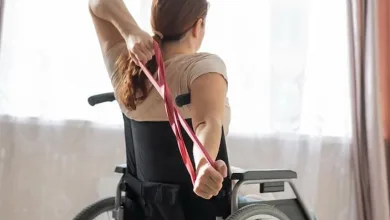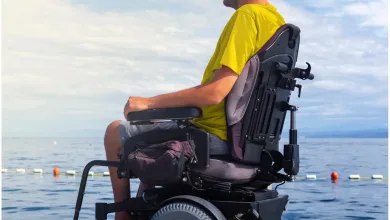Top 7 Caregiver Tips : Empowering Wheelchair Users

Table of Contents
Top 7 Caregiver Tips : Empowering Wheelchair Users
Mastering the Journey: Your Guide to Wheelchair Caregiving
Imagine a world where everyday tasks require a little more planning. This is the reality for many wheelchair users. As a caregiver, you play a vital role in ensuring their comfort, safety, and well-being. But where do you even begin?
Don’t worry—we’re here to help! This comprehensive guide equips you with seven essential caregiver tips for wheelchair users, empowering you to navigate the journey of wheelchair patient care with confidence.
We’ll also dive into crucial aspects of wheelchair care at home, including:
- Daily Care for Wheelchair Users
- Preventing Pressure Sores in Wheelchair Users
- How to Transfer Someone in a Wheelchair Safely
- Wheelchair Exercises for Pressure Relief
- Adapting Your Home for a Wheelchair
So, grab a cup of tea, settle in, and let’s explore these valuable tips together!
1. Daily Care for Wheelchair Users: Mastering the Routine
Daily care for wheelchair users is all about establishing a comfortable and supportive routine. Here’s a breakdown of key areas:
- Personal Hygiene: It is crucial to assist with bathing, dressing, and toileting. Remember to respect privacy and maintain open communication.
- Skin Care: Check for pressure sores regularly (more on this later) and maintain good skin hydration to prevent irritation.
- Medication Management: Ensure timely medication intake by using pill organizers or setting reminders.
- Nutrition and Hydration: Provide a balanced diet rich in essential nutrients and keep them well-hydrated throughout the day.
- Social Interaction: Encourage social interaction to combat loneliness. Plan visits with friends and family or explore online support groups.
Now, let’s tackle a common concern: preventing pressure sores.
2. Preventing Pressure Sores in Wheelchair Users: A Proactive Approach
Pressure sores, also known as bed sores, are a significant concern for wheelchair users. Here’s how to be proactive:
- Regular Pressure Relief: Encourage frequent position changes (every 15-30 minutes) to redistribute pressure. Use pressure-relieving cushions and support surfaces.
- Skin Inspection: Regularly check for signs of redness, warmth, or skin breakdown. Early detection is key!
- Maintaining Skin Health: Keep the skin clean and dry. Use gentle cleansers and moisturizers to prevent dryness and irritation.
- Pros and Cons Chart: Pressure-Relieving Cushions
| Pros | Cons |
| Reduces pressure points | May require adjustments for comfort |
| Improves comfort during sitting | Requires proper cleaning and maintenance |
| Variety of types available (gel, air-filled, etc.) | May add cost |
With pressure sores under control, let’s move on to safe transfers.
3. How to Transfer Someone in a Wheelchair Safely: Mastering the Move
Transfers are a crucial aspect of wheelchair care at home. Here are some essential safety tips:
- Planning and Communication: Discuss and plan the transfer beforehand. Communicate clearly with the wheelchair user throughout the process.
- Proper Body Mechanics: Maintain good posture to avoid back strain for both caregiver and user. Utilize assistive devices like transfer belts when needed.
- Clear Path and Stable Environment: Ensure a clear and unobstructed path for the transfer and a stable and free-of-clutter environment.
Now that transfers are covered let’s explore exercises to relieve pressure.
4. Wheelchair Exercises for Pressure Relief: Moving for Comfort
Wheelchair exercises are a fantastic way to promote circulation and prevent pressure sores. Here are some simple exercises you can do together:
- Ankle Pumps: Flex and point the feet repeatedly to improve blood flow in the legs.
- Shoulder Rolls: Roll shoulders forward and backwards to improve joint mobility.
- Seated Leg Lifts: Lift one leg at a time while keeping the knee straight. Hold for a few seconds and repeat with the other leg.
Tip: Consult a healthcare professional for personalized exercise recommendations based on the individual’s
5. Adapting Your Home for a Wheelchair: Creating an Accessible Oasis
Adapting your home for a wheelchair can significantly improve the user’s independence and overall well-being. Here are some key modifications:
- Widening Doorways: Ensure doorways are wide enough for comfortable wheelchair passage.
- Ramps and Thresholds: Install ramps for navigating steps and consider lowering thresholds for smoother transitions.
- Lowering Cabinets and Countertops: Make kitchens and bathrooms more accessible by lowering cabinets and countertops.
- Grab Bars and Shower Seats: Install bathroom grab bars for support and shower seats for safe showering.
- Non-Slip Flooring: To prevent falls, use non-slip flooring materials in bathrooms and other potentially wet areas.
Now that your home is an accessible haven, let’s explore some frequently asked questions.
6. Empowering You on Your Caregiving Journey
Here are some commonly asked questions regarding wheelchair patient care guide:
- What are some resources for caregivers?
There are numerous resources available online and in your community. Support groups, online forums, and government agencies can offer valuable information and connect you with other caregivers.
- How can I manage stress as a caregiver?
Self-care is essential! Prioritize activities you enjoy, delegate tasks when possible, and seek support from friends, family, or professional caregivers.
- What if I’m unable to provide all the care myself?
Don’t hesitate to seek help! Explore options like in-home care services, adult daycare programs, or respite care to ensure your loved one receives the best possible care.
Transition: Remember, you’re not alone in this journey!
7. The Power of Partnership in Caregiving
The path of wheelchair care at home is rewarding filled with moments of learning, growth, and shared experiences. By implementing these seven caregiver tips for wheelchair users, you’re well on your way to becoming an exceptional caregiver. Remember, communication, respect, and a willingness to learn are vital ingredients for success. Embrace the journey, celebrate small victories, and don’t be afraid to ask for help when needed. Together, you and your loved one can confidently navigate this path and create a supportive and enriching environment.
Additional Tips and Resources for Caregivers of Wheelchair Users
Beyond the seven core tips, here are some additional pointers to enhance your caregiving journey:
- Embrace Technology: Explore assistive technologies like voice-activated controls, smart home devices, and adapted computer programs to promote independence.
- Stay Informed: Attend workshops or online courses on wheelchair care to stay updated on best practices and potential challenges.
- Celebrate Milestones: Acknowledge and celebrate even small achievements, like mastering a transfer or completing a household chore. This reinforces a positive and motivating atmosphere.
- Maintain a Positive Attitude: A positive and encouraging attitude can significantly improve the overall well-being of both the caregiver and the wheelchair user.
- Humour Matters: Don’t be afraid to share a laugh! Laughter can help reduce stress and create a more relaxed environment.
Resource Roundup:
- The National Spinal Cord Injury Association (SCIA): [National Spinal Cord Injury Association | paralysis.org] provides valuable resources and support for wheelchair users and their caregivers.
- The American Occupational Therapy Association (AOTA): [American Occupational Therapy Association | aota.org] offers information on finding occupational therapists who can assist with adapting your home and daily routines for wheelchair users.
- The Christopher & Dana Reeve Foundation: [Christopher & Dana Reeve Foundation | christopherreeve.org] supports research and provides resources for individuals with spinal cord injuries and their families.
Remember: Caregiving is a journey of continuous learning and adaptation. Dedication, patience, and a willingness to learn can create a supportive and enriching environment for your loved one.
We hope this comprehensive guide empowers you on your caregiving journey. For further information on specific aspects of wheelchair care, feel free to consult healthcare professionals.
Remember: By following these tips and fostering a collaborative spirit, you can create a positive and empowering caregiving experience for yourself and your loved one.
FAQs for Professional Caregivers of Wheelchair Users
1. What are the key differences between caring for someone in a wheelchair at home versus a facility?
Home care allows for greater personalization and familiarity for the user. However, facilities often have more extensive medical equipment and staff readily available.
2. How can I effectively communicate with a client with limited mobility or speech difficulties?
Utilize alternative communication methods like picture cards, assistive technology, or gestures. Pay close attention to body language and facial expressions for nonverbal cues.
3. What are some legal and ethical considerations when caring for a wheelchair user?
Please respect their privacy, autonomy, and right to make informed decisions. Be aware of and adhere to relevant healthcare directives and advance care plans.
4. How can I ensure safe and proper transfers for my client?
Maintain proper body mechanics, utilize appropriate assistive devices (transfer belts, gait belts), and always prioritize a clear and stable environment for transfers.
5. What are some strategies for preventing pressure sores in my client?
Perform regular pressure checks, encourage frequent position changes, and utilize pressure-relieving cushions and support surfaces.
6. How can I help my client maintain a sense of independence while providing necessary care?
Involve them in decision-making whenever possible, encourage self-care tasks, and focus on promoting their abilities rather than limitations.
7. What resources are available for professional development in wheelchair care?
Numerous online courses, workshops, and certifications offered by organizations like the American Occupational Therapy Association (AOTA) can enhance your skills.
8. How can I manage stress and burnout as a professional caregiver?
Prioritize self-care through healthy habits, utilize support systems (colleagues, supervisors), and don’t hesitate to seek help from mental health professionals if needed.
9. What are some ethical considerations when working with a client’s family members?
Maintain clear communication and respect for family dynamics. Uphold patient confidentiality while ensuring families are informed and involved in care decisions.
10. How can I advocate for my client’s needs within the healthcare system?
Educate yourself on their medical conditions and care plans. Be a strong and informed voice for their needs when interacting with doctors, nurses, and other healthcare professionals.
So, you are not alone on this journey! Share your challenges and triumphs in the comments section below. We can support each other as caregivers.



